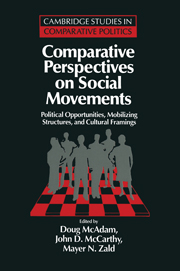 Comparative Perspectives on Social Movements
Comparative Perspectives on Social Movements Book contents
- Frontmatter
- Contents
- Biographical sketches of contributors
- Preface
- Introduction: Opportunities, mobilizing structures, and framing processes – toward a synthetic, comparative perspective on social movements
- PART I POLITICAL OPPORTUNITIES
- PART II MOBILIZING STRUCTURES
- 6 Constraints and opportunities in adopting, adapting, and inventing
- 7 The organizational structure of new social movements in a political context
- 8 The impact of national contexts on social movement structures: A cross-movement and cross-national comparison
- 9 Organizational form as frame: Collective identity and political strategy in the American labor movement, 1880–1920
- 10 The collapse of a social movement: The interplay of mobilizing structures, framing, and political opportunities in the Knights of Labor
- PART III FRAMING PROCESSES
- Notes
- References
- Index
6 - Constraints and opportunities in adopting, adapting, and inventing
Published online by Cambridge University Press: 05 June 2012
- Frontmatter
- Contents
- Biographical sketches of contributors
- Preface
- Introduction: Opportunities, mobilizing structures, and framing processes – toward a synthetic, comparative perspective on social movements
- PART I POLITICAL OPPORTUNITIES
- PART II MOBILIZING STRUCTURES
- 6 Constraints and opportunities in adopting, adapting, and inventing
- 7 The organizational structure of new social movements in a political context
- 8 The impact of national contexts on social movement structures: A cross-movement and cross-national comparison
- 9 Organizational form as frame: Collective identity and political strategy in the American labor movement, 1880–1920
- 10 The collapse of a social movement: The interplay of mobilizing structures, framing, and political opportunities in the Knights of Labor
- PART III FRAMING PROCESSES
- Notes
- References
- Index
Summary
Scholars of social movements have come to a quite broad consensus about the importance of mobilizing structures for understanding the trajectory of particular social movements and broader social movement cycles. The choices that activists make about how to more or less formally pursue change have consequences for their ability to raise material resources and mobilize dissident efforts, as well as for society-wide legitimacy – all of which can directly affect the chances that their common efforts will succeed.
But these same scholars have just begun to account for the comparative historical variation in those structures across societies, across movements, and through time. As they make progress in doing so, we will be better able to generate perspectives that account for how mobilizing structural forms emerge and evolve; how they are chosen, combined, and adapted by social movement activists; and how they differentially affect particular movements as well as movement cycle trajectories. The concepts of political opportunity and strategic framing are, I believe, particularly useful in illuminating these processes.
By mobilizing structures I mean those agreed upon ways of engaging in collective action which include particular “tactical repertoires,” particular “social movement organizational” forms, and “modular social movement repertoires.” I also mean to include the range of everyday life micromobilization structural social locations that are not aimed primarily at movement mobilization, but where mobilization may be generated: these include family units, friendship networks, voluntary associations, work units, and elements of the state structure itself. The encompassing scope of the mobilizing structures concept usefully aggregates all of these many varieties of enabling institutional configurations, allowing us to address their routine dynamics as well as their common reciprocal interrelationships with both political opportunity structures and framing processes.
- Type
- Chapter
- Information
- Comparative Perspectives on Social MovementsPolitical Opportunities, Mobilizing Structures, and Cultural Framings, pp. 141 - 151Publisher: Cambridge University PressPrint publication year: 1996
- 102
- Cited by


